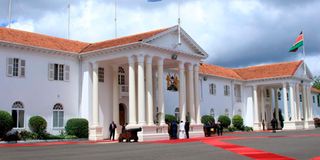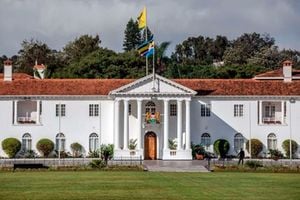
State House, Nairobi.
In his evergreen sonnet Ozymandias, Percy Bysshe Shelley invites us to take a perilous plunge into the yawning, churning vortex of intractable conjecture, at whose abysmal bottom even greater perplexity abounds.
Out of this speculative odyssey only the meanest satisfaction is feasible, especially when any meagre deductions alighted upon are seasoned with the vanishing comforts of that brave saying, “haidhuru”.
The tale of Ozymandias, recounted in sparse yet fluid verse, is at best, a third-hand account of an encounter in an ‘antique land’, whose stupendous potency is accomplished through the fusion of several voices.
First of these is, of course, the narrator, who is the poet, and the other, the traveller implicated in the material encounter. Thirdly, the object, whose dramatic voice is distorted by the decay and collapse wrought by the vagaries of weathering and mass wasting over the course of a long time; to the harsh elements of the desert, add the depredations of sundry vandals, subversives and revisionists.
Arguably, the most important voice in this narrative is borne by the inscription on the pedestal, words which may be variously imputed: directly or indirectly to the imperious figure represented in the work (in all likelihood said Ozymandias, more formally, Rameses II) the sculptor at the behest of other patron or muse.
Shelley’s most audacious accomplishment in this work, executed with mischievous dexterity, is to enlist the most volatile and consequential voice of all: the voice(s) in our head, especially our inner historian, romantic and storyteller breathes life into absurdly arrayed ruins: colossal disembodied legs, standing near a face, partially submerged in the dunes, on which the expression of implacable ferocity endures in vivid defiance.
The poet suggests without suggesting that once upon a time, this junk comprised a most impressive statue, executed with such ambition and grandeur, that its pedestal recorded its author’s intention to awe everyone for all time. “My name is Ozymandias, king of kings: Look on my works, ye Mighty, and despair!”
Millenia of relentless diurnal oscillation between extremely inclement conditions had reduced the terrifying eloquence of the statue into an ironic ruin whose form no longer conformed with its declared purpose.
No one, except the most addled expressionists, observing the desolate underpinnings, missing torso, and a sneer slowly, but surely sinks into the sands of time, would experience awe and not skeptic’s pessimism. Rather, many would entertain a different sort of wonder: how did it appear when first installed?
How did viewers react to it? What took it down? Is more rigorous enforcement of the regulations concerning the trafficking of scrap metal necessary to prevent vandalism? Is there any use for restoration, in order to re-create the towering majesty of this ancient tribute, given that the community, together with the social, cultural and political context to which this extravagant propaganda spoke, vanished into the mists of history?
All ruins proclaim the inadequacy of human conceit against the power of time and nature. At the same time, they bear implicit summons implicitly which can mobilise fanatical devotion to auld lang syne so compelling that present substantive utility is discarded in the service of forms and usages whose purpose has been extinguished into hollow and delusional observances, or even inimical commitments.
A ruinous affliction befalls us whenever we embrace radical notions of legacy, tradition and the suchlike, and we fixate upon articles that have been reduced, by the ineluctable temporal effluxion, to obsolete, redundant or positively deleterious encumbrances.
Often, this arises from anachronistic allegiances to form and the violent rejection of the contemplation of purpose, underlying values and motivating principles which constitute the substantive dimension of human artefacts. This type of fundamentalism facilitates a disingenuous denial of contradictions which constitute the oppressive conceptual and practical baggage that must be borne by every delusional adherent of hollow tradition.
In analysing the furore which greeted disclosures that State House, Nairobi, is undergoing an overhaul, it is useful to consider the possibility of an outbreak of a pestilential streak of this ruinous affliction.
A typical symptom was the blatant disregard for the stated purpose of the renovation works: to rehabilitate and modernise the edifice after a full century of steady decay by enhancing its structural integrity, improving overall utility, in terms of capacity to accommodate more work spaces, providing ample amenities for different formats of state functions, and to dispense access to ICT.
Critics insist that it is absolutely imperative to maintain all aspects of the ancient design even if that entails tolerating every species of vulnerability, damage, and inefficiency.
The nation’s architects protested, with most animated disapprobation, that the neoclassical design of the nation’s most focal address was ‘iconic’ and constituted our national heritage and must never be altered, even slightly.
By all accounts, a conception of heritage exclusively defined in terms of gabled roofs and ionic columns, without regard for purpose or function is astonishing.
We must listen to Shelley’s voice in Ozymandias; we experience a different species of despair when we behold ruins, however splendid we imagine them to have once been.
The writer is the Secretary, Policy Messaging and Speechwriting, The Presidency.







